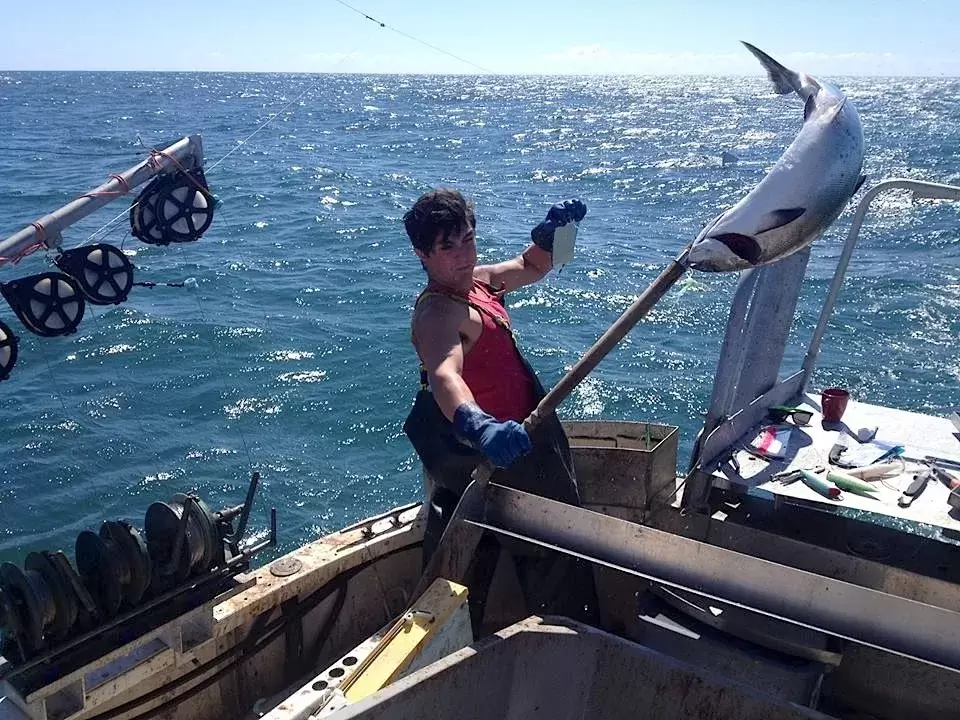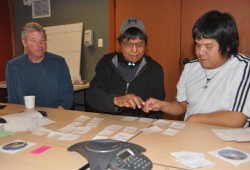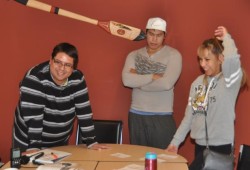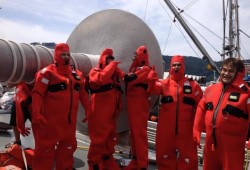They lost sleep one night thanks to a tsunami alert and a number of students came down with the flu, but members from nine Nuu-chah-nulth nations completed a week of marine safety training and certification at the Tseshaht office on Jan. 26.
The Small Vessel Operator Proficiency (SVOP) certificate is a requirement for operators of vessels five tonnes or less, working less than 25 nautical miles from shore, passenger boats (less than 12 passengers, such as sport-fishing, crew boats, whale-watching and water taxis) and cargo vessels. The ticket also covers commercial fishing vessels under 15 tonnes.
SVOP training includes navigation, vessel construction and stability, boat handling and the Canada Shipping Act.
On Friday, Jan. 26 Ha-Shilth-Sa dropped in on the Radio Operators Certificate (ROC) session. An ROC ticket is required by any boater or vessel operator using a VHF or MF [Medium Frequency] marine radio.
“They will also require Marine First Aid, which we will offer in Tofino at a later date,” explained trainer Roy Alexander, who serves as fisheries advisor for the Hayu Fishing Partnership.
Hayu is a joint venture created under the Pacific Integrated Commercial Fishing Initiative (PICFI), and is owned by Toquaht, Ehattasaht-Chinehint, Nuchatlaht, and Hesquiaht First Nations. Alexander said the Hayu training initiative involves a complex set of relationships, but the result is cost-effective and doesn’t require individual nations to set up their own bureaucracies.
“It’s really a partnership of all kinds of agencies. But we felt we had to start it somewhere,” he said.
Most training takes place through government agencies, Alexander explained. Worksafe BC originally created FishSafe, to provide training. PICFI was created in 2007. For Nuu-chah-nulth nations, training programs are provided by the Nuu-chah-nulth Education and Training Program (NETP).
“But often, they miss people,” he said. The complicated-but-effective partnership sees trainees registered through NETP, which also provides the training rooms. Hayu covers the cost of food and accommodations.
“All applicants go into the NETP data base,” Alexander said, noting that the data also helps NETP identify training gaps.
To apply for a training session, the applicant merely has to contact his or her band office.
“We call it the PUP Program – pick up the phone,” he said.
John Krgovich is the Program Coordinator for FishSafe, and he delivered the ROC training on Friday.
“These courses that they have been taking [other than ROC] are Transport Canada, so they are not only for commercial fishing,” he said. “So anything like whale-watching or water taxies or charter fishing. It’s not specific.”
Part of the training involves learning the standard radio vocabulary. On Friday, trainees were handed a brief scenario and asked to make the appropriate call. “Man overboard,” a collision, a warning to nearby vessels – each must be broadcast to reflect the magnitude of the incident or circumstances.
That comes down to “Mayday” (distress call), “Pan Pan” (urgency) or “Securité” (safety). The operator must identify the vessel and provide an accurate location in a brief, succinct fashion.
Curtis Michael is a member of Nuchatlaht First Nation, currently working at an Ehattesaht oyster farm.
“I’ve been on the water for 30 years, but this is the first time I’ve actually gotten a boat ticket,” he said. That includes the radio certificate, Michael added. Good thing, he noted.
“I thought I knew this stuff. But that last exercise showed me I didn’t,” he said.
“Even with the SVOP, I’ve been on the water for 30 years, and I got about 95 per cent, but I picked up stuff I didn’t know.”
Ruth Sam is a member of Tseshaht who has taken part on the fishery on the Somass River, but who now intends to acquire a bigger vessel and move out onto the Alberni Inlet, “Where all the big boats go.”
“I fished on the river with my late brother Gooch – Ken Sam Jr.,” Sam said. “We’re going to apply for a bigger boat. Right now, we have a cute little 12-footer. We’d like a 20-footer. So I have to learn how to operate a larger boat.”
Sam said she had never operated a marine radio. Did the SVOP class provide any surprises? She was asked.
“Everything,” Sam replied, adding, “But I did well on the exam.”
The goal now is to absorb those book lessons into everyday skills, she said.
Ditidaht member Samuel Edgar works as a fisheries technician in the Ditidaht fisheries program.
“Last season was my first season with them,” Edgar said. “I worked May through September. But it’s a seasonal position. I am looking to work my way up to a [nations] fisheries officer, and this is one of the steps.”
Edgar said he has not worked on the radio much.
“Usually my skipper does all the radio work. He was certified and I wasn’t, so I didn’t go on much,” he said. “Now that I’m certified, I’ll be carrying my own radio.”
Edgar said the SVOP training threw some surprises at him.
“There was quite a bit of stuff I didn’t know,” he said. “Like what the buoys meant – the colours, the navigation [instructions] – I had never really noticed them or understood them. Now that I’ve had the course, I recognize them.”
Krgovich said once the students pass the ROC exam, they receive a temporary permit for three months, before receiving their permanent ticket.
Whether students attend to learn new skills to forge a new career, or simply to formalize skills they have already learned through long experience, the program has provided certification for men and women across the Nuu-chah-nulth territories.
“Hayu has trained over 150 students thus far – closer to 200,” Alexander said. “Tla-o-qui-aht First Nation is going to provide the next room.”










